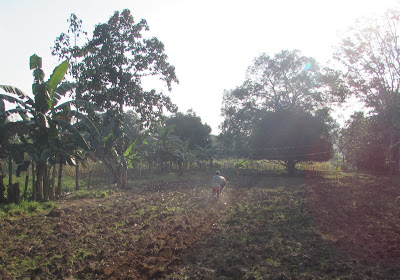The photos at the beginning of this post are of a bicycle powered transport common in Sibulan, known locally as a putt-putt. I took the photos while out on my morning walk today, and upon arriving back home, I posted the photos onto my Facebook page, along with the words -
Next time you feel like your job sucks, just be thankful you don't have to drive a putt putt for a living.
I didn't receive many reactions to the photos and editorial comment, perhaps because my American friends don't quite understand what's involved in getting about on a putt-putt.
Later, while on an errand in Sibulan proper, I saw quite a few putt-putts conveying passengers (and a few in between fares). Naturally, I couldn't resist taking more photos.
I feel it's worth mentioning that, at the times these photos were taken, the outdoor temperature was 86° Fahrenheit (30° Celsius). I was pretty damn well hot driving my car with the windows down - I can only imagine peddling this contraption, with riders no less.
Tuesday, January 28, 2020
Philippines in the 21st Century
Although I'm not particularly fond of the term, I am what is referred to as an expat living in Philippines. We live in a small town, in a rural part of the barangay, and yet, while we are not in the center of things, there are far more isolated areas in the country. Never the less, even here, in an area that one of my brothers might have called Bumfok Egypt, we have access to fiber optic cable television and Internet.
Fiber optic technology definitely puts us into the late 20th - early 21st centuries.
Yet in spite of being in "modern times", often I feel as if I've entered a TARDIS and have traveled back in time as I go walking about in my immediate area. An example of this mental disconnect can be seen in these photos, taken within a ten minute walk from our house in Magatas, Sibulan.
Back in the U.S., I knew a few folks in rural Georgia and Alabama who might have garden areas similar to the one the man in these photos works, but in the U.S., the work would be done with tractor - or tiller at least. I never met anyone in the States still using an animal to plow the field.
I imagine that some in the First World might be praising the man for being "green", by his not using a machine powered by fossil fuels or his not applying chemical fertilizers to the soil. No gasoline, or diesel. Carabao manure for fertilizer.
Does this enter his mind?
Would he rather be brought into the future?
Monday, January 27, 2020
Sunday, January 26, 2020
New Piglets
Yesterday, while my brothers in-law were preparing the lechon baboy, the sow went into labor, giving birth to ten piglets.
Sadly, one piglet has already died.
These photos show the sow just before giving birth, followed by the first piglets born.
The final photos show the nine remaining piglets, as they feed this morning.
Finishing the Lechon Baboy
In two posts from yesterday, I chronicled the preparation of a lechon baboy for the celebration of my in-laws' 43rd wedding anniversary.
In this post, I will include photos of the final steps.....the baboy, as it is nearly complete, and photos of the lechon on the dining room table.
Saturday, January 25, 2020
Preparing the Lechon Baboy
In my last post [Hogtying The Pig ] I published a series of photographs documenting the early stages of getting a pig ready to become the lechon baboy. Those photos showed the hogtying of the animal prior to it being slaughtered along with a few photos taken after the slaughtering.
The photos in this post show the removal of hair from the carcass, the washing of the pig and the beginning of the roasting.
As with my earlier photographs, some may not wish to view these and might question why I post them. These photos document life as it is in Philippines today. This is the way things are here - it is not a whitewashed portrayal.
Subscribe to:
Comments (Atom)






















































